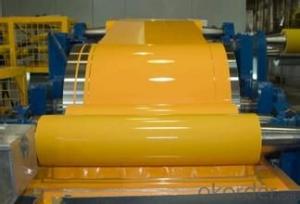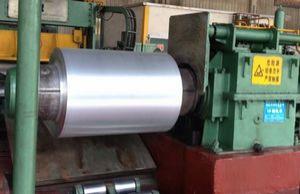1100 Aluminum Coils for Sale - Cold Rolling Aluminum Coils for Color Prepainting
- Loading Port:
- Shanghai
- Payment Terms:
- TT or LC
- Min Order Qty:
- 5 m.t.
- Supply Capability:
- 5000 m.t./month
OKorder Service Pledge
OKorder Financial Service
You Might Also Like
1.Structure of Cold Rolling Aluminium Coils for Color Prepainting
Cold Rolling Aluminium Coils for Color Prepainting is one semi-finished aluminium material. This strip can be rolled down to aluminium coil,sheet,circle ect. The alloy AA1050 is widly used in building, industry ect. Its weight is much lower than steel. So many customers choosed aluminium material instead of steel.
2. Main features of the product
a.Competitive price---We have our own mills and can produce mill finished aluminium coils, so we can control the production cost better.
b.Professional after-sale service---We have more than 15 years exportation experience and you need not worry about the exporation problems.
c.Fast delivery time---We can control the delivery time within 35 days.
3.Image



4. Products Specification
| Alloy | Temper | Color Coating | Coating Thickness | Weight |
| AA1050 | H14 | Polyester | 22-25 microns | 2 tons |
5. FAQ
What is the quality standard?
---Usually our standard is GB3880-2006
What is the largest width?
---It is 2300mm
What is the MOQ?
---Usually we can accept 80 tons.
- Q: Can aluminum coils be fabricated or machined?
- Yes, aluminum coils can be fabricated or machined. Aluminum coils are typically used in applications such as heating, ventilation, and air conditioning (HVAC) systems, automotive radiators, and electrical transformers. These coils can be fabricated or machined to meet specific requirements and dimensions. Fabrication of aluminum coils involves processes such as cutting, bending, and welding to create the desired shape and size. This allows for customization and adaptation to various applications. Machining, on the other hand, involves removing material from the aluminum coil using cutting tools such as lathes, mills, or CNC machines. This process is used to achieve precise dimensions, smooth finishes, and intricate designs. Overall, aluminum coils are versatile and can be fabricated or machined to suit different needs. The flexibility of aluminum as a material makes it a preferred choice for many industries, offering durability, lightweight properties, and excellent thermal conductivity.
- Q: Is it possible to use an aluminum coil as a wire in electronic devices?
- <p>While it is technically possible to use an aluminum coil as a wire for electronic equipment, it is not typically recommended. Aluminum has a higher resistivity than copper, which is the standard material for electrical wiring due to its lower resistivity and higher conductivity. This means aluminum wire may not conduct electricity as efficiently, leading to increased energy loss and potential overheating. Additionally, aluminum can oxidize, which may further degrade its conductivity over time. For most electronic equipment, copper wire is preferred for its superior electrical properties and reliability.</p>
- Q: where is aluminum found in the world or in the universe?do u think aluminum is more valuable to people than gold?why or why not?im just lazy to look up the answers and person 4 best answer 10points
- where is aluminum found in the world aluminum is in fact the third most common element in the Earth's crust, and it is the most common metallic element on Earth. In a pure form, aluminum is silvery white and extremely lightweight. aluminum is more valuable to people than gold? aluminum continues to remake the modern world. We can see it everywhere; in architecture, transportation, electrical cables, communications and consumer products. Because it’s light-weight, strong, versatile and easy to recycle, aluminum is becoming more and more valuable in our daily lives melting point and boiling point Melting Point: 933.437 K (660.323°C or 1220.581°F) Boiling Point: 2792 K (2519°C or 4566°F)
- Q: i know aluminum nitrate will dissociate, and also that there is no way that the nitrate will react to make the solution basic or neutral. But what about the aluminum ion? Does it take OH- from water to make [Al(OH)4]- and make the solution acidic? Does it somehow take protons and make a basic solution? My teacher said its not neutral, so I'm leaning towards an acidic solution. Thanks!
- Aluminum nitrate is the salt produced by the reaction of aluminum hydroxide and nitric acid. Nitric acid is a strong acid. Aluminum hydroxide is a realtively weak base. So the salt will be acidic.
- Q: How do aluminum coils compare to iron coils in terms of weight?
- Aluminum coils are significantly lighter than iron coils.
- Q: How are aluminum coils used in the production of cans and containers?
- Aluminum coils are used in the production of cans and containers as they are rolled into thin sheets that can be shaped into the desired form. These coils are fed into a machine where they are cut, formed, and joined together to create the body of the can or container. The lightweight and corrosion-resistant properties of aluminum make it an ideal material for packaging, ensuring the preservation and protection of the contents inside.
- Q: Can aluminum coils be formed into different shapes?
- Yes, aluminum coils can be formed into different shapes through various processes such as bending, rolling, or stamping.
- Q: How do aluminum coils compare to galvanized steel coils in terms of longevity?
- In terms of longevity, aluminum coils generally have a longer lifespan compared to galvanized steel coils. Aluminum is naturally resistant to corrosion, which means it is less likely to rust or deteriorate over time. This makes aluminum coils a popular choice for outdoor applications, such as in roofing, siding, and HVAC systems, as they can withstand harsh weather conditions without losing their structural integrity. On the other hand, galvanized steel coils are steel coils that have been coated with a layer of zinc to protect against corrosion. While this zinc coating provides some level of protection, it can wear off over time, particularly in areas with high humidity or exposure to saltwater. Once the zinc coating is compromised, the steel underneath becomes susceptible to rust and corrosion, which can significantly reduce the lifespan of galvanized steel coils. Therefore, if longevity is a primary concern, aluminum coils are generally a more durable and long-lasting option compared to galvanized steel coils. However, it is important to consider other factors such as cost, specific application requirements, and maintenance needs before making a final decision.
- Q: Are aluminum coils resistant to vibration?
- Yes, aluminum coils are generally resistant to vibration. Aluminum is a lightweight and flexible material that can absorb vibrations and dampen their impact. Additionally, aluminum coils are often used in applications where vibration resistance is important, such as in HVAC systems, automotive parts, and electrical transformers. The high strength-to-weight ratio of aluminum also contributes to its ability to withstand vibrations without deforming or breaking. However, the exact level of vibration resistance may vary depending on the specific design and construction of the aluminum coil.
- Q: What are the common international standards and certifications for aluminum coils?
- Quality and compliance with industry requirements in aluminum coils are ensured through several common international standards and certifications. These include the following: 1. The International Organization for Standardization (ISO) has a globally recognized standard, ISO 9001, which focuses on quality management systems. This standard ensures that manufacturers have implemented effective quality control processes throughout their production and supply chain, resulting in consistent and reliable aluminum coils. 2. The American Society for Testing and Materials (ASTM) develops and publishes technical standards for various materials, including aluminum coils. One commonly referenced standard is ASTM B209, which covers the general requirements for flat-rolled aluminum products, including aluminum and aluminum-alloy sheets and plates. 3. European Norms (EN) have established EN 485, a European standard that specifies the mechanical properties, dimensions, and tolerances of aluminum and aluminum alloys. This standard ensures that aluminum coils manufactured in Europe comply with the specified quality and performance requirements. 4. The Japan Industrial Standards (JIS) committee has developed JIS H 4000, a set of standards for aluminum and aluminum alloys. JIS H 4000 covers the chemical composition, mechanical properties, and dimensions of aluminum coils, ensuring their suitability for various applications. 5. The Aluminium Stewardship Initiative (ASI) Certification is a global initiative that promotes responsible production, sourcing, and stewardship of aluminum. This certification ensures that aluminum coil manufacturers adhere to strict environmental, social, and governance standards, including responsible sourcing of raw materials and sustainable production practices. 6. The United States Aluminum Association offers certification programs, such as the Aluminum Transportation Group (ATG) Certification, which ensures that aluminum coils meet the industry's specific requirements for automotive, aerospace, and other transportation applications. These standards and certifications provide customers with assurance that the aluminum coils they purchase meet the necessary quality, performance, and sustainability standards. It is crucial for manufacturers and suppliers to adhere to these international standards to gain credibility and maintain the trust of their customers in the global market.
Send your message to us
1100 Aluminum Coils for Sale - Cold Rolling Aluminum Coils for Color Prepainting
- Loading Port:
- Shanghai
- Payment Terms:
- TT or LC
- Min Order Qty:
- 5 m.t.
- Supply Capability:
- 5000 m.t./month
OKorder Service Pledge
OKorder Financial Service
Similar products
Hot products
Hot Searches
Related keywords




























